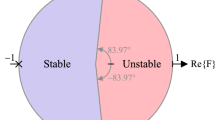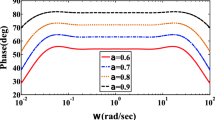Abstract
A new kind of filter called Legendre chained-function (LCF) filter with characteristic function given by the product of low-degree Legendre orthogonal polynomials (seed functions) is studied in this paper. LCF filter magnitude response exhibits unequal ripple level in the passband compared to Chebyshev chained-function filter with identical edge ripple factor at the passband edge. A proper combination of seed functions, i.e., a product of them, is used to control the maximum ripple in the passband, which affects the return loss, selectivity and a group delay characteristics of a filter. By selecting one of the possible combinations of seed functions (thus obtaining various degrees of freedom in filter design), filters with improved performances compared to traditional approximation techniques can be obtained. The degrees of freedom increase if the degree of filter increases. Compared to existing Chebyshev chained-function (CCF) filters, whose performances are also presented, and Butterworth function filters as a special case of both LCF and CCF filters, the new family of LCF filters has many advantages. A table summarizing properties of CCF and LCF filters is given for design purpose.







Similar content being viewed by others
Notes
The loaded quality factor \(Q_\mathrm{L}\), defined as the ratio of the magnitude of the resonator response at resonance frequency to the total circuit resistance, can be calculated for each resonator using [19]:
$$\begin{aligned} 1/Q_\mathrm{L}=1/Q_\mathrm{u}+1/Q_\mathrm{e} \end{aligned}$$where \(Q_\mathrm{e}\) is external Q-factor.
Approximately 99.7% of the data values lie within three standard deviations from the mean.
References
M. Abramowitz, I. Stegun, Handbook of Mathematical Functions with Formulas, Graphs, and Mathematical Tables. National Bureau of Standards Applied Mathematics Series 55, 9th edn. (Dover, New York, 1972)
A. Budak, P. Aronhime, Transitional Butterworth–Chebyshev filters. IEEE Trans. Circuits Theory 18(5), 413–415 (1971)
S. Butterworth, On the theory filter amplifier. Exp. Wirel. Radio Eng. 7, 536–541 (1930)
C.E. Chrisostomidis, S. Lucyszyn, On the theory of chained-function filters. IEEE Trans. Microw. Theory Tech. 53(10), 3142–3151 (2005). doi:10.1109/TMTT.2005.855358
M.T. Chryssomallis, J.N. Sahalos, Filter synthesis using products of Legendre polynomials. Electr. Eng. 81(6), 419–424 (1999)
S.B. Cohn, Dissipation loss in multiple-coupled-resonator filters. Proc. IRE 47(8), 1342–1348 (1959). doi:10.1109/JRPROC.1959.287201
S. Darlington, Synthesis of reactance 4-poles which produce prescribed insertion loss characteristics: including special applications to filter design. J. Math. Phys. 18(1–4), 257–353 (1939). doi:10.1002/sapm1939181257
H.G. Dimopoulos, Analog Electronic Filters: Theory, Design and Synthesis (Springer, Dordrecht, 2012)
M. Guglielmi, G. Connor, Chained function filters. IEEE Microw. Guided Wave Lett. 7(12), 390–392 (1997). doi:10.1109/75.645181
J.S. Hong, M.J. Lancaster, Microstrip Filters for RF/Microwave Applications (Wiley, New York, 2001)
A.B. Jayyousi, M.J. Lancaster, F. Huang, Filtering functions with reduced fabrication sensitivity. IEEE Microw. Wirel. Compon. Lett. 15(5), 360–362 (2005). doi:10.1109/LMWC.2005.847713
A. Kumar, A. Verma, Design of Bessel low-pass filter using dgs for RF/microwave applications. Int. J. Electron. 103(9), 1460–1474 (2016). doi:10.1080/00207217.2015.1126860
S. Kumari, S. Gupta, N. Pandey, R. Pandey, R. Anurag, LC-ladder filter systematic implementation by OTRA. Eng. Sci. Technol. 19(4), 1808–1814 (2016). doi:10.1016/j.jestch.2016.10.003
Z.D. Milosavljević, M.V. Gmitrovic, Design of maximally selective generalized Chebyshev filters. Circuits Syst. Signal Process. 21(2), 195–205 (2002). doi:10.1007/s00034-002-2006-8
J. Neirynck, L. Milić, Equal ripple tolerance characteristics. Int. J. Circuit Theory Appl. 4(1), 99–104 (1976). doi:10.1002/cta.4490040110
H. Orchard, Loss sensitivities in singly and doubly terminated filters. IEEE Trans. Circuits Syst. 26(5), 293–297 (1979). doi:10.1109/TCS.1979.1084643
H.J. Orchard, Inductorless filters. Electron. Lett. 2(6), 224–225 (1966)
D. Packiaraj, K. Vinoy, M. Ramesh, A. Kalghatgi, Design of compact low pass filter with wide stop band using tri-section stepped impedance resonator. AEÜ Int. J. Electron. Commun. 65(12), 1012–1014 (2011). doi:10.1016/j.aeue.2011.03.018
D.M. Pozar, Microwave Engineering, 4th edn. (Wiley, New York, 2011)
S. Prasad, L.G. Stolarczyk, J.R. Jackson, E.W. Kang, Filter synthesis using Legendre polynomials. Proc. IEE 114(8), 1063–1064 (1967)
S.C.D. Roy, Modified Chebyshev lowpass filters. Int. J. Circuit Theory Appl. 38(5), 543–549 (2010). doi:10.1002/cta.585
K. Srisathit, Simple technique to extend the bandwidth of parallel-coupled microstrip bandpass filter, in 9th International Symposium on Communications and Information Technology, 2009. ISCIT 2009 (2009), pp. 901–914
N. Stamenković, V. Stojanović, On the design transitional Legendre–Butterworth filters. Int. J. Electron. Lett. 2(3), 186–195 (2014). doi:10.1080/00207217.2014.894138
S. Winder, Analog and Digital Filter Design, 2nd edn. (Elsevier Science, Woburn, 2002)
Y.S. Zhu, W.K. Chen, On the design of Butterworth or Chebyshev broad-band impedance-matching ladder networks. Circuits Syst. Signal Process. 9(1), 55–73 (1990). doi:10.1007/BF01187721
A.I. Zverev, Handbook of Filter Synthesis (Wiley, New York, 1967)
Acknowledgements
The authors wish to thank Professor V. S. Stojanović of the University of Niš, Niš, Serbia for his valuable comments and suggestions. The work presented here was partly supported by the Serbian Ministry of Education and Science in the frame of the Projects TR 32009.
Author information
Authors and Affiliations
Corresponding author
Rights and permissions
About this article
Cite this article
Stojanović, N., Stamenković, N. & Krstić, I. Chained-Function Filter Synthesis Based on the Legendre Polynomials. Circuits Syst Signal Process 37, 2001–2020 (2018). https://doi.org/10.1007/s00034-017-0651-1
Received:
Revised:
Accepted:
Published:
Issue Date:
DOI: https://doi.org/10.1007/s00034-017-0651-1




